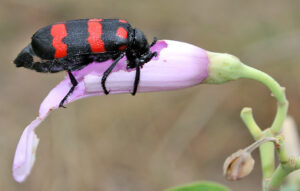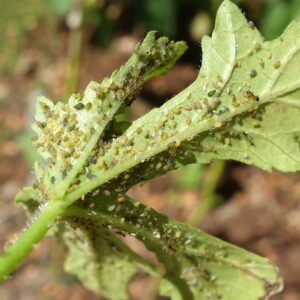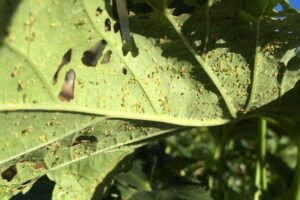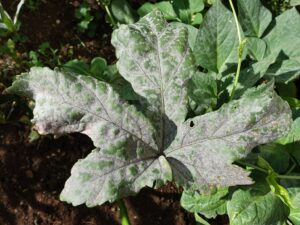Okra
Okra is an annual crop belongs to Malvaceae family. It is mainly grown in tropical and sub-tropical region. It occupies 5th position, next to tomato, in area under vegetable in the country. The crop is cultivated for its young tender fruits. It is a good source of Vitamin A and B, protein and minerals. It is also an excellent source of Iodine and is useful for treating Goitre. Fruits are also dried or frozen for use during off season. Dry skin fiber are used in manufacture of Paper, cardboard and fibers.
In north it is cultivated in rainy and spring season. In rainy season, it is cultivated in June-July and for spring season it is cultivated in February-March.
India is the largest producer of okra in the world. In India, major okra growing states are Uttar Pradesh, Bihar, West Bengal, Gujarat, Orissa, Maharashtra, Andhra Pradesh, Madhya Pradesh, and Karnataka, Assam.
Okra is a tropical and subtropical crop and cannot tolerate frost. For sowing optimum temperature required is 20-29oC, during harvesting the temperature should be 25-35oC. Rainfall should be 1000mm.
Okra can be cultivated in wide range of soils but prefers loose, well drained and rich soil. The ideal pH should be 6-8.
For rainy season, use seed rate of 4-6kg/acre with 60*30cm for branching varieties and 45*30cm for non-branching varieties. For February use seed rate of 15-18kg/acre and for sowing in March use seed rate of 4-6kg/acre.
Seed treatment-
Seed germination can be enhanced by soaking the seeds in water for 24 hours. Seed treatment with Carbendazim will protect the seeds from fungal attack. For that soak seeds in Carbendazim solution @2gm/L of water for 6 hours and dry them in shade. For better germination and to protect seeds from soil borne disease, treat seeds with Imidacloprid @5ml/kg of seeds followed by treatment with Trichoderma viride @4gm/kg of seeds.
The land is prepared by giving 5-6 ploughings and levelling is done by 2-3 planking. Apply well decomposed cow dung @100qntl/acre in soil at the time of last ploughing. Ridges and furrow type of layout is use.
Subsequent irrigation is given at fixed intervals depending on texture of soil and climate. A light irrigation is given immediately after sowing to ensure proper germination. Pre sowing irrigation should be given in summer season crop to ensure good germination if sufficient moisture is not present in the soil. The next irrigation is given after germination. Then field is irrigated after 4-5 days in summer and 10-12 days in rainy season.
Apply 20-25 tonnes of Farmyard Manure as basal dose at the time of final ploughing. Overall okra crop requires 36kg/acre Nitrogen in form of Urea @80kg/acre. Apply half dose of Nitrogen at the time of sowing and remaining after first picking of fruits. One third dose of Nitrogen, full Phosphorus and Potassium are to be applied as basal dose.
To obtain good yield, spray 19:19:19 after 10-15 days of sowing along with micronutrients @2-3gm/L of water. Repeat this spray after 10-15 days of first spray. To obtain good flowering and fruiting spray 00:52:34 @50gm/10L of water at before onset of flowering followed by another during fruit formation. To increase yield and to obtain good quality, spray 13:00:45 @100gm/10L of water during fruit development stage.
Weed growth should be control till crop canopy covers. Frequent hoeing, weeding and earthing up should be done. First weeding is done after 20-25 days after sowing and second weeding is done after 40-45 days of sowing.
Pre-emergence Herbicide- Pendimethalin30EC is effective against wide range of broadleaf and grassy leaf. It should be used @1L/acre
Post-emergence Herbicide- Glyphosate 41% SL, kills most of the plants. It should be used @300ml/acre.
1. Nitrogen-
A nitrogen deficient okra plant exhibit pale yellow leaves, stunted growth and reduced fruit production. Fertilizer rich in nitrogen such as ammonium nitrate or urea should be applied at recommended rates during planting and periodically throughout the growing season.
- Potassium-
Potassium deficiency manifest as burnt leaves margins, reduced fruit size and increased susceptibility to pest and disease. Applying potassium rich fertilizer such as potassium sulfate or muriate of potash before planting or during fruiting stage.
- Phosphorus-
Deficiency symptoms include slow growth, purple coloration in leaves, delayed flowering. Incorporating Phosphorus rich fertilizer such as super phosphate or bone meal at the time of planting helps establishing strong root system and improves overall plant health.
- Shoot and Fruit Borer-
Stage of attack- Vegetative
Symptoms of damage-
- Borer infestation results in toppling and death of young seedlings.
- Withering and drying up of individual leaves and central shoot.
- Fruits may be damaged in severe infestation.
- Infested fruits present a deformed appearance and become unfit for consumption.
Management-
- Grow resistant varieties
- Collect and destroy damaged plants and maintain field sanitation.
- Set up Pheromone trap @2/acre
- Spray Carbaryl 50%WP @60g/100L of water or Endosulfan 35 EC @2ml/L of water.
- Blister Beetle-
Stage of attack- Fruiting stage
Symptoms of damage-
- The beetle feeds on pollen, flowers and buds.
- Reduces the number of pods that are set.
- Inflorescence become barren without flowers and may dry up.
- Blister Beetles feeds on leaves leads to severe defoliation. This can reduce plant’s ability to photosynthesize, affecting the growth and yield.
- They create irregular holes in the leaves, which can sometime leads to complete skeletonization.


Management-
- Set up Pheromone trap @3/acre
- Apply any one of the following insecticide-
Azadirachtin @800ml/acre
Emamectin Benzoate 5%SG @1gm/L of water
- Aphid-
Stage of attack- Vegetative and Fruiting stage
Symptoms of damage-
- Both adults and nymph suck the sap thus weaken the plant.
- In severe infestation, they causes curling and defoliation of leaves.
- They secrete honey dew like substance and sooty black mould is developed on affected parts.


Management-
- Collect and destroy affected plants from the field.
- Apply Dimethoate @300ml/150L of water
- Jassids-
Stage of attack- Early stages of crop growth
Symptoms of damage-
- Marginal yellowing of leaves, cupping and drying of leaves
- Defoliation also occur in heavy infection
- The margin of the leaves start curling downward and reddening sets in.
- The margins of the leaf get broken and crumble into pieces when crush.
Management-
- Treatment of seeds with Imidaclopird or Thiamethoxaim
- Foliar application of Thiamethoxaim @80ml/acre
- Nematodes-
Stage of attack- Seedling, Vegetative, and Fruiting
Symptoms of damage-
- Root Knot Nematode infects root causing galls premature leaf falls.
- Wilting of leaves
- Stunted growth of plants
- Premature wilting of plants
- Leaf chlorosis
Management-
- Crop rotation with non-host plants
- Deep ploughing during summer
- Apply Carbusulfan @500ml/acre
- Whitefly-
Stage of attack- Vegetative stage
Symptoms of damage-
- Chlorotic spots on leaves
- Irregular yellowing of leaves
- Severe infestation leads to premature defoliation
- Development of sooty mold
- Vector of yellow mosaic virus
Management-
- Application of following insecticide-
Acetamiprid 20%SP @60-80gm/acre
Imidacloprid 70%WG @2gm/L of water
- Rotate crop with non-host crop
- Remove and destroy infected plant debris and weeds which can harbor whiteflies
- Introduce natural predators such as lady beetles, lacewings and parasitic wasps that prey on whiteflies.
- Apply neem oil, which disrupts the life cycle of whiteflies and acts as a deterrent.
- Leaf Roller-
Stage of attack- Vegetative or Fruiting
Symptoms-
- Leaf roller feeds on leaf margins and causes feeding damage to the leaves
- Causes curling and twisting of leaves
- In severe infestation, premature defoliation occurs
- Leaves become dry, leathery and thick.
- Plants shows stunted symptoms
- Terminal shoots wither and drops
- Shedding of flowers and buds
- Bore holes in fruits and feed
Management-
- Set up Pheromone trap @3/acre
- Collect and destroy infected plants from the field
- Apply following insecticide-
Azadirachtin 300ppm @2gm/L of water
Emamectin Benzoate 5%SG @3gm/10L of water
- Yellow Vein Mosaic Virus-
Causal Organism- This disease is caused by Begomovirus
Symptoms-
- This is the most serious disease of okra
- Vein clearing is the characteristic symptom of this virus.
- Affected fruits may turn cream or white in color.
- Virus is transmitted through whitefly
- Yellowing of entire veins and leaf blades
- Flowers formed may be small and hard
Management-
- Removal of weeds
- Control of whitefly
- Collect and destroy affected plants
- Cultivate disease resistant varieties
- Application of Azadirachtin 300 ppm @5gm/10 L of water
- Cercospora Leaf Spot-
Causal Organism- Cercospora malayensis & abelmoschi
Symptoms-
- Sooty, black moldy fungal growth appears on under surface of the leaves.
- Mature pods are also attacked and shows blackish spots.
- Severely infected leaves drop off resulting in fruits yield
- Older leaves which are closer to ground surface are mostly affected with this disease.
- The leaves become dry and brown as the disease progress.
Management-
- Spray Bavistin @1gm/L of water
- Cultivate disease resistant varieties
- Foliar application of Copper oxychloride @2.5gm/L of water
- Powdery Mildew-
Causal Organism- Erysiphae chicoracearum
Symptoms-
- White powdery pustules appears on lower surface of the leaves
- In severe conditions, yellowing and death of leaves may also occur.
- White powdery fungal growth on leaves
- Purple to reddish blotches may appear on leaves

Management-
- Spraying of wettable sulfur @2gm/L of water at fortnightly interval may control this disease.
- Spray Penconazole @10ml/10 L of water
- Root Rot-
Causal Organism- Fusarium solani
Symptoms-
- Yellowing of leaves
- Wilting and drying of leaves
- Stunted growth in severe infection
- Poor fruiting, affecting yield
- Dropping of leaves

Management-
- Select disease resistant variety
- Implement proper drainage and soil management
- Maintain field sanitation practices
- Use copper based fungicides to treat root rot
- Fusarium Wilt-
Causal Organism- Fusarium oxysporum
Symptoms-
- Symptoms begin with yellowing and wilting of plant
- In severe cases, seedling dies completely
- Leaves drop off if infection severe
- Stunted growth
- Cutting the stem of an infected pant reveals brown or reddish- brown discoloration of the vascular tissue. This is a diagnostic feature of Fusarium Wilt.
- The roots may appear discolored, decayed or underdeveloped, which compromises the plants ability to uptake water and nutrients.
Management-
- Treat seeds with Mancozeb @3gm/kg of seeds
- Drench the field with Copper Oxychloride 50%WP @2gm/L of water
- Plant disease resistant varieties
- Remove infected plants from the field and maintain field sanitation.
- Damping Off-
Causal Organism- Rhizoctonia solani
Symptoms-
- Seedling stems with become water soaked and thin
- Young leaves wilt and turn green-gray to brown.
- Stunted growth of the plants
- Seedlings kill before emergence
- Disease spread through soil and seeds
Management-
- Avoid stagnation of water
- Drench soil with copper oxychloride 50%WP @2gm/L of water.
- Use disease resistant varieties
- Treat seeds with Captan or Thiram @4gm/kg of seeds
The fruits are ready to harvest in 60-70 days after sowing. Harvest fruits when they attain maximum size but still tender. Harvesting is done in alternate days with a knife. For harvesting, cotton cloth hand gloves should use to protect fingers from stinging effect. Harvesting should be done during morning hours as this time fruits are tenderer as compare to evening hours.
Yield- Average yield of 40-80qntl/acre.
Okra has short life and cannot be stored for long time. The Okra should be stored at 7-10o C and 90% RH to increase the shelf life. Fruits after harvesting are graded and filled in jute bags or baskets or perforated cartons. Pre-cooling of fruits before packing maintains turgidity of fruits and will save it from bruises.